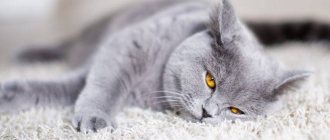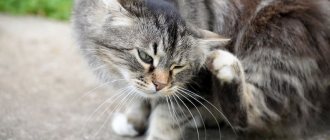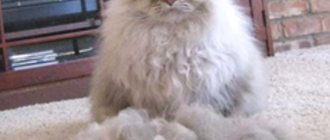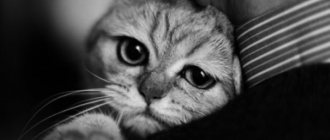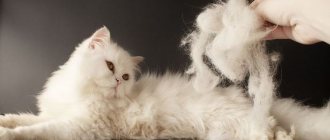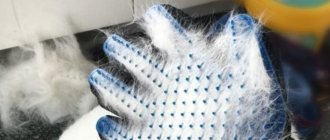For every cat owner, a source of pride is its shiny and beautiful coat. As soon as the cat begins to actively lose its fur, spreading its fur throughout the apartment, especially when the cat's shedding is prolonged, the owners begin to worry. And the cause of concern is not only frequent wet cleaning in the apartment due to the large amount of cat hair, but also whether your pet is sick.
Is shedding normal in a cat or is it one of the symptoms of some disease?
Seasonal shedding. Molting is inherent in all living beings. A cat living in a city apartment is no exception. In the spring, cats change their “coat” in accordance with the growing warmth in nature, and in the fall, with the approach of cold weather, that is, the cat’s owners observe the process of losing and growing new hair. During shedding, the cat behaves as usual, its appetite is preserved, and it does not outwardly look sick. When a cat sheds, it leaves behind a large amount of fur. To keep your pet's coat smooth and fluffy during shedding, try to choose the highest quality premium food. Brush your cat regularly using special brushes and combs. In cats living in city apartments, shedding can last from 2 to 3 months.
Apartment molt . Cats living in an apartment shed all year round, despite good nutrition, absolute health and quality care. Such cats practically do not feel the change of seasons: the molting period in indoor cats stretches for several months, or even the whole year. Indoor shedding intensifies in winter, when the heating starts working in the house or apartment, and the drier the air in the room, the stronger the cat’s shedding. Air conditioners, air humidifiers, and even simple aquariums can partially help owners cope with indoor shedding. For such a cat, owners need to choose suitable food and professional hygiene products (shampoo, conditioner, nourishing masks). Anti-shedding vitamins for cats are effective, but they should not be abused - a maximum of two monthly courses per year.
Baby shedding is the process of changing a kitten's fur to adult fur. Kittens begin to shed at 6 months of age. Molting in kittens continues for 1-2 months. Coarser adult hair grows back, which is thicker and heavier than baby fur. At the same time, the patterned kittens become brighter - the ghostly haze disappears, and the slight fading of the fur, necessary for camouflaging the young, disappears. The dark areas of the skin of Siamese and Burmese become brighter and richer. During a child's coat change, no remedy for shedding cats will help; the owner can only comb the coat daily and make sure that the baby is fed well. The better the living conditions, the faster the coat will change and the more beautiful the adult coat will be.
Pregnancy and feeding kittens . Loss of a significant amount of hair, up to partial baldness, can also be noted in pregnant cats because... During pregnancy, a profound restructuring of metabolism occurs in a cat’s body, and the cat primarily spends the nutrients supplied with food on building the body of the kittens and on their subsequent feeding. After a cat stops feeding her offspring, her coat returns to normal and looks like before pregnancy.
Old age of the cat. Owners often notice thinning fur in older cats around the ears and face. This hair loss does not require special drug treatment; you will need to consult a specialist about feeding an aging cat.
Stressful situations - all animals, including cats, can worry and experience severe nervous overexcitation, which ultimately negatively affects their health, as well as the quality of their coat. A trip to the country, a change of place of residence, the arrival of a new tenant, a fight with its relatives during a walk, meeting a dog, quarrels between family members can become reasons for a cat’s distress. If your pet sheds because of this, then it is important to create a calm atmosphere, surround it with attention and care, and provide sedatives.
Improper grooming is often the reason why a cat sheds all year round. In the case when the cat is clinically healthy, and the change in coat is not pronounced - it sheds little by little and all year round, it is necessary to pay attention to the composition of shampoos, the quality of brushes and other grooming tools. Owners should brush their cat at least once a week: gentle movements with the brush stimulate blood circulation, improving nutrition of the hair follicles and reducing shedding. Shampoos and conditioners must be chosen specifically for cats, and do not forget to dilute them as written on the packaging.
Why and how cats shed
Shedding in cats is a natural, regular process of changing coat. Shedding in animals happens for different reasons and at different times.
Shedding is a common occurrence in cats.
Seasonal
In a normal situation, a cat sheds twice a year:
- the beginning of cold weather. The transition to the winter season is signaled by a decrease in daylight hours, a decrease in temperature, and this turns on protective mechanisms in animals. Cats quickly grow new fur to keep them warmer in cold weather.
- onset of heat. In summer, the hair grows lighter so that it does not get hot.
Cats who roam freely react the most to the change of season. Their body senses weather changes more strongly and reacts more sensitively.
Pets that are not allowed outside also shed, but regardless of natural conditions. Shedding occurs once or twice a year.
Seasonal molting lasts about a couple of weeks to two months. If the shedding continues, you should contact your veterinarian.
According to breed characteristics
In cats with long, thick fur, this process occurs much more noticeably.
Mustaches are divided into 4 types:
- long-haired;
- semi-longhaired;
- short-haired;
- hairless.
The shorter the coat and thinner the undercoat, the less problems with shedding.
Seasonal molting and its timing
Seasonal molting occurs twice a year: from February to March, the cat gradually prepares for summer, getting rid of winter fur, and from September to October, on the contrary, it strives to make room for a warm winter coat. The timing of shedding may vary depending on the breed of the cat, its climate zone, and the pet’s living conditions, but on average it lasts 2–3 weeks.
During shedding, a cat's behavior may change somewhat: it becomes less active, licks itself frequently, and some pets become irritable. But the general condition should not suffer: the nose should be cold, the eyes should be clean, the food should be eaten, and the tray should be visited as scheduled.
During normal shedding, the amount of fur a cat sheds increases, but does not become excessive . The replacement occurs evenly, without the formation of areas of focal alopecia (baldness).
During shedding, the cat often licks itself to remove dead hairs.
When do kittens start moulting?
Little kittens hardly shed; instead of fur they have baby fluff.
But caring for the fur of kittens should begin at a young age, as it will be much easier to accustom them to brushing.
However, caring for a kitten’s fur coat, and, in particular, brushing, must begin from an early age. It is much easier to train a small kitten to be groomed than an adult. Also, early brushing will help prepare them for their first shed.
It's easier to train a kitten to brush
Kittens begin to shed at about six months (5 – 8 months). Not only the fur changes, but also its color. When cats begin to shed for the first time, which can be up to 6 months, it is the most intense because the body is subject to a complex maturation process.
Prevention
In order to prevent hair loss in cats, owners must take a number of preventive measures. Such measures will preserve the cat’s skin and prevent the development of more serious diseases.
Prevention of hair loss, heavy shedding and baldness in cats includes:
- Timely and regular vaccination against infectious diseases common in your region.
- Proper care of the animal's fur.
- Regular treatment of the skin against ectoparasites
- Periodic deworming against worms.
- During a walk, try to protect the cat from contact with sick and stray animals.
- Create favorable living conditions for the cat in the apartment.
- Feed with a balanced diet rich in vitamins.
- Protect your cat from possible stress.
- Conduct regular preventive examinations at your veterinary clinic.
Causes of severe shedding
The normal state of health of an animal during molting is if:
- Skin of normal color.
- The wool does not fall out in clumps, leaving no bald spots.
- The cat has a normal appetite and a healthy appearance.
- There is no unpleasant odor from the mouth or ears.
- body temperature is normal.
Hair loss is almost never the only symptom of any disease.
But sometimes the shedding becomes very strong.
Apartment molt
This type of shedding is common in pets. It is especially aggravated during the heating season, when the air in the apartment becomes very dry. You can use a humidifier to avoid excessive hair loss.
Apartment shedding is stronger during the heating season
Hormones
Unneutered cats who are not sexually active may suffer from hormonal imbalances. This greatly affects the condition of the pet’s skin.
Hormones can fluctuate after estrus, during pregnancy and after childbirth, just like in humans.
If you do not breed cats, then it is better to have surgery. If this is not possible, your doctor may recommend a course to avoid hormonal imbalances.
Stress
Cats have a very good nervous system. But even they are susceptible to stress under certain conditions:
- Change of habitual habitat.
- A trip in public transport, a long road.
- The appearance of a new animal in the house.
- Long-term loneliness.
- Change of habitual way of life (usually lack of affection, new prohibitions, etc.)
Cats shed a lot due to stress
Try to save your cat from unnecessary worries and isolate him from unusual situations. If the shedding goes away, then the problem is definitely due to stress.
Improper care and feeding
Owners should take very good care of their beloved pets. Feeding and care are the main things we need to provide them with. Care products must be strictly individual and suitable for the cat’s breed (shampoos, brushes, ointments).
The diet must be balanced; you cannot feed cats food from the table. Good animal feed contains all the necessary microelements and substances.
Hair loss also occurs due to dysbiosis after treatment with antibiotics. Intestinal function is disrupted.
Old age
As cats age, their body begins to work worse, their immune system weakens, causing their fur to become thin, dull, and fall out. This is a natural life cycle.
Cats lose fur as they age
Allergy
An allergy is a skin reaction, namely inflammation, redness, itching. This ailment occurs as a result of a change in the usual diet.
Allergies are usually accompanied not just by hair loss, but by the formation of bald patches.
In case of allergies, hair falls out due to damage to the skin.
A possible allergen should be excluded and the process of hair loss should be monitored.
Diseases and parasites
Severe hair loss is caused by a number of diseases, both skin and internal. This is already a pathology.
Skin diseases:
- Ringworm, fungal infections.
- Demodicosis (subcutaneous mites);
- Dermatitis (due to flea secretions, ectoparasites).
- Scabies (Notoedris cati mite).
- Eczema.
In case of allergies, hair falls out due to damage to the skin.
All of these diseases are characterized by clear lesions and are accompanied by irritation and fur loss.
Internal diseases include endocrine system disorders, including diabetes mellitus or neoplasms. In these cases, baldness is a secondary symptom and the primary cause must be dealt with.
Kittens' first molt
Kittens have their first moult
is accompanied by the replacement of undyed hairs with the hair of adult animals and occurs
this is most often
at the age of 5-7 months, in spring or autumn
. When purchasing kittens, you should understand that their color will likely change. Shedding starts from the head and gradually continues throughout the kitten's body. The animal's head will receive its permanent color before other parts of the body, and the rest of the body can molt for a whole year or even more.
Ways to reduce shedding
It is impossible to get rid of natural shedding. Only serious illnesses require drastic interventions. And in normal times, we can only slightly reduce hair loss.
Vitamin complexes
Supplements reduce the amount of hair loss. Be sure to consult with your veterinarian about which vitamins are right for your pet.
Vitamins help against hair loss
Along with the supplements, you can give yolk (if you are not allergic) and sprouted grass.
Sprouted grass is useful in combination with vitamins
Buy a special paste for removing hairballs from the body of cats.
Special feed
A balanced diet is very important during such a period.
To ensure that the fur is always beautiful and healthy, and molting is not a severe torment, the animal’s food must contain: biotin (vitamin B7, deficiency leads to inflammation in the hair follicles. Acute biotin deficiency can lead to baldness) taurine, sulfur (enhances the effect of biotin ), vitamins B6, B2, B5, iodine, calcium, phosphorus, omega-3, omega-6.
Cat food is rich in essential nutrients
If the cat's diet consists of regular foods, then biotin and vitamin B6 must be present, which are found in beef, pork, chicken yolk, salmon, poultry, cheese, carrots, and buckwheat. But keep in mind that cats may be allergic to “human” food.
Dry food must be of high quality, at least super premium. They have everything you need to feed your pet.
There are two types of food recommended for consumption during shedding:
- Food for healthy skin and coat.
- Food for removing hair from the stomach.
Bathing and brushing
During washing and combing immediately after bathing, a very large amount of dead hair is removed.
More fur is combed after bathing
For cats with short fur, it is enough to brush them a couple of times a week with a regular comb. For fluffy, long-haired breeds, you will most likely have to take a Furminator. This is a professional device with very fine teeth.
Cats with long and thick hair are best combed with a furminator.
Methods for reducing hair loss
If there are no pathological causes of shedding that require immediate contact with a veterinarian, we will try to reduce it and correct the consequences.
The right diet
First of all, we will ensure that the cat’s body receives all the necessary substances. A pet's diet should include all the necessary macro- and microelements, vitamins and fatty acids. When eating only natural food, there may be a lack of Omega-3 and Omega-6, because... the body of a Scots cat does not produce these substances. A lack of vitamins is also possible.
Another feature of the Scots is their inability to produce enough calcium on their own. Therefore, in the case of eating natural food, it is necessary to introduce supplements of these substances.
Suitable dry food already includes everything you need. However, it is better to compare the content of its elements with the established standards mandatory for this breed, and, if necessary, introduce additives. The daily value is indicated on the package and depends on the age and weight of the animal.
Wet food is the same in content, but contains water. It is advisable to use food of the same brand.
Felinologists do not recommend giving natural food (for example, raw meat) and dry food at the same time, because Digestion of these categories requires a different composition of enzymes.
With increased hair loss, the animal licks itself more often. Clumps of lost hairs accumulate in the stomach. To get rid of them, you can plant grass on the windowsill that your pet will eat. There are drugs, the use of which allows you to regurgitate scraps that have entered the stomach.
Complete coat care
When a cat grows hair, you need to take extra care of it. We need to bathe the Scotsman more often. Shampoo can cause allergies, so it is better to use an already proven product.
If this is not the case, you need to observe the cat after taking a bath to see if there are any signs of allergies. It is better to comb out falling hairs with a brush glove designed for this purpose. This should be done 1-2 times a day.
Reducing stress levels
If increased shedding is associated with a move, renovation, the arrival of a new family member, the death of the owner, or simply the arrival of guests, there is reason to suspect fear, excitement, or nervous overexcitation of the pet as its cause. These may be changes in behavior (the animal hides, does not eat, etc.) or in appearance (pupils are dilated, ears are flattened, the tail is shaking).
The manifestations of stress are individual, as is the cause of its occurrence. Someone may be scared of going to the veterinarian or leaving the apartment, while others are afraid to swim.
The owner's affection and attention, as well as medications, will help reduce fear and anxiety. Be sure to talk to your pet out loud. because he understands the intonation of the voice of the owner and his family members.
Under no circumstances should you scold or punish the animal at this moment. You can play with him, pet him, give him a treat, let him lie next to him or on your lap. When moving, the previous things will help - bedding, a house, etc.
If psychological methods fail to reduce stress, your veterinarian will prescribe medications. You should not give your cat products intended for humans (for example, valerian).
Why is it important to remove dead hair?
Villi that have already fallen out but are not removed from the cat’s body can cause irritation and itching on the animal’s skin. It actively licks off excess fur and tries to remove it with its paws.
This can be dangerous because when hairballs get into the stomach, gastrointestinal upset and intestinal obstruction begin.
Hair getting into the stomach leads to intestinal disorders and causes nausea
With its paws, a cat can scratch itself, which serves as a breeding ground for infections that cause skin diseases.
Wool flying around the house can cause allergies in allergy sufferers living in the house, especially in the spring.
How to deal with shedding
Almost all cat owners ask this question. Some are sincerely concerned about the health of their ward, others are more concerned about the condition of the furniture and carpets.
Let's reveal a terrible secret: hair loss in cats cannot be cured.
Inaction is the best course of action
Above we have listed the six most likely causes of excessive shedding. Of these, only the last requires intervention, and only because hair loss in this case is an indicator of the presence of a disease that needs treatment. Moreover, there is no need to “help” a cat with seasonal or age-related (children’s) shedding; this process, even if it lasts for a whole year, does not cause any inconvenience to the animal.
Those who advise buying their pet vitamins “for the fur” are either their manufacturers (distributors) or naive victims of advertising.
If a cat receives a balanced diet, it does not need any additional vitamins.
As a rule, under this “sauce” we are offered drugs with unproven effectiveness, which, however, absolutely does not exclude side effects, including allergies.
Houseplant poisoning is not uncommon for cats.
If an animal sheds its fur, but still looks healthy and happy, it does not need treatment.
Treatment
Having made a diagnosis, the veterinarian prescribes treatment. It will be aimed at restoring the coat, as well as eliminating the cause of hair loss in the cat.
Treatment methods:
- If the problem of hair loss is associated with an allergic reaction of the cat to certain allergens, the animal must be completely protected from this allergen. After this, medications are prescribed to enhance immunity. If the allergy is caused by food, then it is necessary to put the cat on a hypoallergenic diet.
- For skin lesions caused by ectoparasites (ticks, fleas and lice), a veterinarian will prescribe special antiparasitic drugs (fleas in a cat). You will need to include vitamins and nutritional supplements in your diet to strengthen your cat’s immunity.
- If hair loss on the cat’s body appears as a result of an infectious disease, monovalent and associated vaccines against microsporia and trichophytosis are used - Mikkanis, Vakderm, Vakderm-F, Microderm, Polivak-, Pushnovak, etc.
When treating ringworm, veterinary specialists also use medications such as: Ketoconazole, Itraconazole, Griseofulfin, and so on. In this case, it is recommended to use immunosupportive agents and medications to improve metabolism. It is important to remember that ringworm is transmitted to humans.
- Hair loss caused by stress in cats is treated with special calming medications.
- Treatment of hair loss caused by subcutaneous parasites is described in our articles - demodicosis in cats, otodectosis in cats, notoedrosis.
- For endocrine disorders in a cat's body, hormonal medications are prescribed.
Ways to solve the problem
When a shaggy pet begins to shed seasonally, it is necessary to comb the fur every day with a furminator, (if the dog is long-haired) - a special comb in the form of a rake, which removes excess undercoat and does not touch living hair. At the same time, a good massage of the pet’s skin occurs, provided that there are no inflammations, scratches, bites or ulcers on it. This device is suitable for almost all breeds except American Water Spaniel, Bedlington, Chinese Crested, Terrier, Frise, Curly Coated Retriever, Lapdog and Poodle. To comb long-haired dogs, you can also use bristle brushes and slicker brushes, which also remove down. For short-haired dogs, you should use more gentle means, such as brush gloves and grooming loops, which can be purchased at a veterinary pharmacy or pet store.
During heavy shedding, it is not recommended to bathe dogs frequently, but once every two weeks you can take a shower with animal shampoos with protein to strengthen hair. Dull, brittle wool often indicates a lack of vitamins, so you need to systematically include in your faithful friend’s diet vitamin complexes that improve the quality of wool, as well as fish oil, which is rich in saturated and unsaturated fatty acids, preparations with copper and zinc, beef and chicken liver.
If there is constant heavy hair loss, you need to find the cause by checking the following:
- make sure that the temperature in the apartment does not exceed 25 degrees; if it is warmer, then it is bad for the dog, so it is necessary to ventilate the room daily.
- Keep track of your pet's diet; meat, fish (once a week) and high-quality dog food are needed every day.
- if there was stress, then you can eliminate it with the help of special drops for dogs, which are sold in a veterinary pharmacy.
- if there are worms, then the dog will itch especially from behind, it will experience either diarrhea, constipation, or bad breath. In this case, you need to contact a veterinarian.
- take a blood test to determine if there are problems with the liver and pancreas.
- If an allergic reaction is detected, you need to perform an allergy test and scraping to identify the cause of skin diseases.
- A lack of vitamins can be eliminated by contacting a specialized pharmacy. You can take a course of vitamins (1 month) - Beafar, 8 in 1 Excel, Polydex. If it is more convenient to give vitamins in liquid form, you can purchase Beafar Laveta or Vittri vitamins.
Under any circumstances, the dog must be taken out for walks more often, even in bad rainy, windy, or frosty weather. Since, getting used to room conditions, the dog’s immunity weakens, the risk of colds and infectious diseases increases. Hardening a pet in combination with physical activity, jogging, and playing in the fresh air is an excellent means of both treating and preventing any disease.

